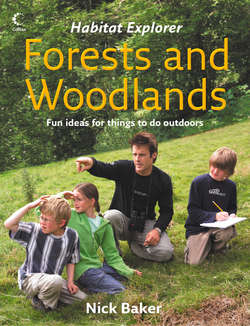Читать книгу Forests and Woodlands - Nick Baker - Страница 6
The tree canopy
ОглавлениеA tree on its own is never a tree on its own. Trees act like a life magnet. You can have a plain bare patch of grass with nothing much in the way of wild life hanging around. But stick a tree in the middle of it and it’s a whole different story. Birds will perch in it and may nest there, insects will find it attractive and nibble or even breed in it. As the tree gets bigger, it creates more living space for even more life.
Making an inventory of a tree near you is always a fun thing to do, and would be a great idea for a personal project or something you can do at school. Try to count as many living things as you can, from the microscopic algae that give the cracks in the bark a greenish tinge, to the birds and mammals that visit. You will be very surprised at what you find.
But just imagine what happens when you stick a collection of these incredible trees together! The effect is magnified, which is why woodlands are such amazing places to explore and why some people make such a fuss when they get removed.
This chapter is about the trees themselves – what they are, how they live and grow. Get to know the trees and you will begin to understand and love the heart of the wood itself.
Fab facts
Here are some BIG numbers for the big European oak:
* 40 hectares of woodland can support 300–400 birds.
* 30 different types of lichen have been found on the bark of these trees.
* 200 species of moth live on the leaves.
* 45 true bugs suck its juices and stalk other prey among its branches.
* 65 mosses and liverworts can be found on the bark.
* 40 species of galls have been found on oak trees.
An oak apple or gall may end up on the woodland floor, but while it’s alive, it grows much further up a tree, near the tree canopy.
A grey squirrel’s drey, neatly perched high in the canopy.
The dappled sunshine emerging through the tree canopy is always a cheering sight.
